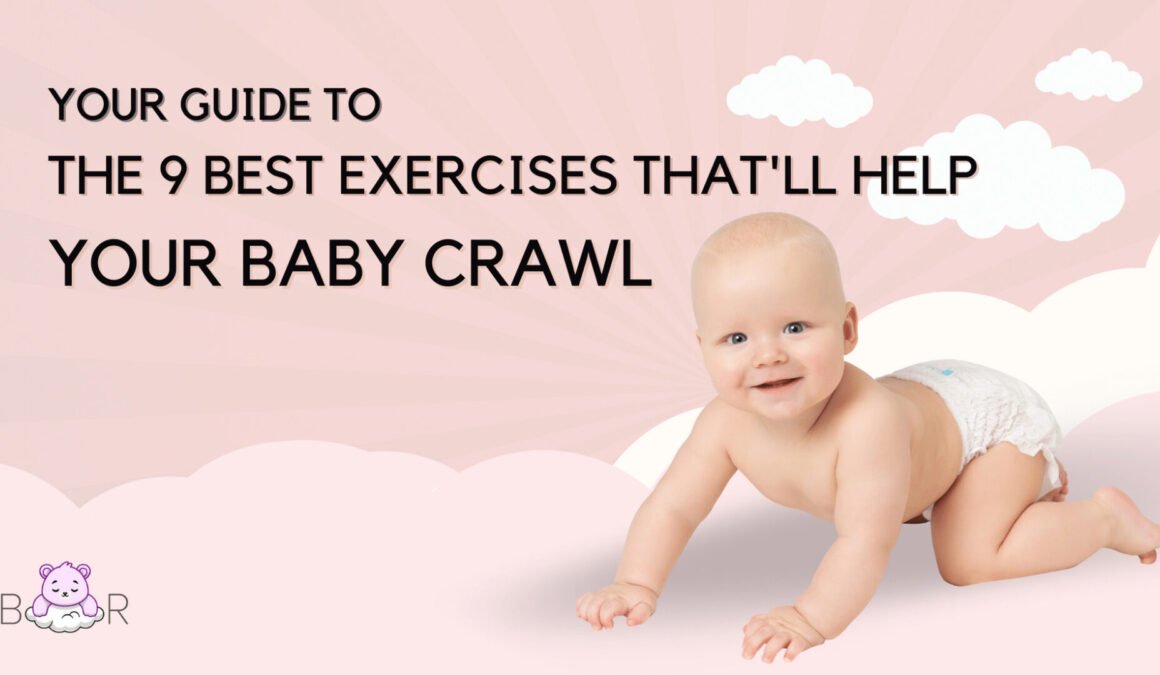Your Guide To The 9 Best Exercises To Help Baby Crawl: [Research-Based]

Parents are always keen to witness the age milestones of their babies, whether it be their first child or last.
Crawling is one of the elementary events that parents must watch out for when their baby hits a certain age.
Babies usually start to crawl between 6 to 10 months of age.
If your baby is currently under this age group, there is a high chance you might be a concerned parent looking for exercises to help baby crawl.
If this is the case, my good friend, you are at the right place! This article focuses on exercises to help babies crawl.
Watching your baby sit up, lift their head, crawl, and walk can all be exhilarating milestones for you to witness.
Recently, CDC has updated its baby milestones checklist, and it does not contain crawling as an age milestone.
However, according to the paediatric physical therapist Kaitlin Rickerd, parents and caregivers should not consider this milestone trivial in a baby’s life.
She also believes that these changes in the list may lead to unintended delays in a referral or elongate the treatment plans. According to her;
“Some of the changes—including removing crawling—inadvertently send the message to parents and caregivers that certain milestones no longer matter, when that just truly isn’t the case.”
We suggest you carefully observe all the activities of your baby and watch out for any irregular behavior or other delayed milestones.
Therefore, I have carefully curated this article to help you undertake appropriate actions that could help your baby crawl.
Table of Contents

The 9 Best Exercises to Help Baby Crawl
Developmental baby exercises, baby workouts, and baby yoga can help to strengthen the muscles of your baby and aid them to crawl and ultimately walk as well.
Finding the best exercises to help your baby crawl or walk can be a challenging task.
We understand that it gets a bit tedious to scour through each article and spot the best exercises for your baby.
So, we have carefully compiled this list because we know your time matters!

1. Exercise to Help Your Baby Rollover
Your baby may initially start to roll over as a sign that they are ready to move to the next stage.
They may start to roll over as early as 4 months and you have to keep an eye on them from there.
Many times, your young one will roll over on their own.
However, they may need assistance with that, and trust me, as a parent, you have ways to help!
Facilitating through Hips
This exercise can help stimulate rolling over in your baby by propelling their legs which is one of the first steps to help them in motion.
To perform this exercise, you can place your child on a smooth surface on their back.
Now, carefully bend one leg so that it comes on the side, over the other leg.
Slowly release your assistance on the leg and perform the same motion on the other leg as well.
You can intrigue your baby’s interest in the exercise by placing a baby exercise toy in front of them.
Your cute tot may try to reach out for the toy that can further propel the motion on its own.

2. Exercise to Help Your Baby Sit Up
Babies’ heads usually stabilize by 4 months old. At around 6 months of age, they may start to sit up with a little support.
These little movements will slowly transition into crawling.
Moreover, these initial movements are also necessary to stabilize the muscles of the baby and assist them in crawling.
Here is a way to help your baby transition toward a sitting position.
The Transition from Lying to Sitting Position
There comes a time eventually when your baby needs to sit up from a lying position independently.
They need more control towards weight bearing and appropriately flex and extend their arms and elbows to sit upright.
This exercise will help your baby develop strong muscles to transition from a lying to a sitting position.
Place your baby on his/her back on a smooth surface.
First, slightly rotate their trunk on one side so they have support on their forearm. Then, extend their elbow joints.
Finally, pull them into a sitting position while holding their hands.
Slightly older children may take assistance from the edge of the bed to help them pull over to a sitting position.

3. Exercises to Help Baby Crawl
First, we need to work on the muscle groups of the baby.
It can strengthen your baby’s arms for crawling, legs, and core.
If you want an answer on how to strengthen the arms of your baby, Quadruped exercises might just be the answer.
Quadruped New-born Exercises
This is the beginning position of crawling. It allows you to train and strengthen your baby’s body and muscles.
I’d like to call it baby core exercise as it also helps them to develop a curve in their spines and reinforce their core.
This will ultimately aid them in walking.
To help your baby perform this exercise, adjust them on their knees while their hands support their weight on the ground.
It will resemble a “knees crawling” position.
At the same time, pull their pelvis upward and backward to help them gain control of this position.
Also, help the baby to rock their shoulders over their wrist by gently moving them back and forth.
Quadruped Reaching
Babies usually lie on their bellies and try to reach the items from this position.
However, we can make this challenging for them by fixating them on the knee crawl position.
Support the underarms of the baby by placing your hand in a C-shaped position.
Make sure that your baby grabs the object while their knees and shoulders support them on the ground.
Place an item in front of the baby they would reach out for.
Encourage them to take the object.
This will help them push their body and will enable them to grab the object securely.
You can also rotate your hands under the baby’s arms to help them stabilize.
Make sure to switch between the left and right hands of the baby so that the muscles of both hands can have a great baby workout day!
4. Exercise to Assist Crawling
We all know that babies love amusing things.
Well, honestly speaking, they are easily fascinated by everything around them and will try to reach out for it.
At this time, the baby is already ready to crawl.
The best you can do is assist them in the crawling position and they’ll manage the rest on their own.
Fix your baby in the knee crawl position while their palms support their shoulders.
Hold the pelvis of your baby and give it a wiggle.
Then, while holding the pelvis with one hand, shift your baby’s leg forward with your other hand.
Perform this motion alternatively for both legs until they reach their target object.
Leave them on their own intermittently so that they are encouraged to crawl on their own without your assistance.

5. Yoga Exercises to Help Baby Crawl
Yoga for babies is as necessary as any other exercise to get them moving.
It can relieve constipation, colic pain, or gas, thus eliminating any irritable factor and allowing your baby to perform their movements joyously.
Here are a few infant yoga moves that can assist your baby in crawling.
Happy Baby Yoga Pose
This pose is usually acquired by babies when they are lying on their backs.
This exercise will stretch and open their hip muscles to make their body more flexible for crawling.
If your baby does not perform this yoga pose on their own, this is how you can help;
Allow your baby to lie on their back while having their legs raised in the air.
Then, make them hold their feet and rock them back and forth.
At this point, your child may grab their feet by themselves.
If not, you do not have to worry.
Just bend them slightly while they are wide open, and this yoga for infants will work just fine.
Butterfly Twist Yoga
This baby stretch yoga is perfect to help your infant sleep and relax their muscles.
The babies’ yoga calls you to lay your baby on their back while their legs and soles are in the air in a butterfly shape.
Then, while holding the arms of the baby to their sides, gently press their feet to their stomach.
While maintaining the same position, gently move their legs to their sides.
You can also talk to your baby during this entire procedure so that they are more relaxed and keep their arms still.
Furthermore, you can add to your baby’s comfort by rocking them back and forth.
This yoga pose for infants can assist in flexibility, and the more your baby is relaxed, the less cranky they are!

6. Neck Strengthening Exercises to Help Baby Crawl
When it comes to crawling, you might ask how to strengthen the baby’s neck so that your baby does not feel burdened.
Well, we have some great solutions to your query because, let me tell you, strengthened neck muscles are essential to help your baby crawl.
Tummy Time
It is considered one of the best baby neck-strengthening exercises.
To perform this exercise or activity, lie your little one on their belly in a comfortable area.
Make sure that area beneath them is clean and not too cold.
You can place a mat underneath them and distribute their toys in the surroundings to provide a comfortable region.
It will allow your tot to explore their surroundings by raising their head.
You may also speak encouraging words for which they may try to look at you.
Thus, it will help to increase your baby’s neck strength.
You may have a great bonding time with your baby during this exercise.
A cobra stretch over your baby may be the best way to make them gaze up in your direction.
Your baby may lean up for a kiss, an action that will stretch his/her neck muscles.
Tummy time also prevents positional plagiocephaly, which means “flattened head.”
Baby on Your Shins
Sometimes, parents are looking for alternative exercises to answer the question of; how to strengthen their baby’s neck without tummy time.
Because honestly, your young one may not feel entertained by a single exercise for a very long.
Lying your baby on your shins is one of the best baby necks strengthening exercises.
To perform this, you have to lie down on your back and bend your legs so that both your shins are parallel to one another.
Now, carefully lay your baby on your legs while their head is hanging off your knees.
You can also move your leg in an airplane position or in general to keep your baby entertained.
It is a great alternative to tummy time.
It can allow for more flexibility in the neck muscles while also giving you and your little one a good bonding time.
The Guppy Baby Position
It is also known as “Reverse Tummy time” as it allows your baby to stretch their neck and extend their chin.
This is my absolute favourite exercise because it is not only it is an impeccable new-born stretching technique, but it also aids in reducing tension under the baby’s tongue.
To perform this exercise, you have to settle down on a chair or a sofa.
Next, place your baby on your lap so that their head is hanging off your knees.
Lay them perpendicular to you, and you can put a hand on their chest to hold guppy pose baby.
The goal is to let them have some motion in their neck while resting in this position.
To fulfil this purpose, place objects or a mirror in front of your baby so they stay entertained.
To further perform guppy poses, you can also lean your baby’s head in your arm or a pillow.

7. Baby Stretches to Help Your Baby Crawl
Assisting your baby in stretches is as necessary as performing any other exercise.
It will help them build and strengthen their muscles and allow room for flexibility.
These stretches can be considered baby physical therapy exercises.
Here are your options for baby stretches that can aid them in crawling.
Knee Against the Chest
Babies have stayed curled in your womb for nine months.
So, naturally, they like to maintain this position.
All you have to do is help them straighten their arms and legs out so that their upper and lower back can be strengthened and their hips and chest feel the stretch.
To perform this infant stretching, place your baby on a surface with their back on it.
Now hold their right calves and bend their leg.
This will bring their knee close to their chest.
You have to maintain a straightened position of the left leg.
In a gentle and continuous motion, perform these infant stretches on the left leg as well.
I personally suggest that you speed up your motion every now and then to give your baby’s legs bicycle motion so that the stretch may become equivalent to baby aerobics.
Kicking and Boxing
This baby exercise involves fun gripping and punching motions that help to stimulate their fine and gross motor skills.
Moreover, it increases baby strength by strengthening their arms and legs.
To perform this exercise, place your thumb in your child’s hand and encourage them to hold onto it.
Now slowly bend and stretch their arms at the elbow joint as if they are placing punches in the air.
In the meantime, utter encouraging words such as “Good Job,” or “Punch!”.
Your baby picks on such cues and gets motivated to perform the motion.
You will see an excited baby who is ready to move their body.
You can also perform these new-born exercises with their legs.
Sit your thumb underneath their toes and help them curl them up.
Then, they swiftly and smoothly perform bicycle motions with their legs as if they are kickboxing.
Make sure to encourage your baby through sound effects in this instance as well!

8. Exercises to Help Baby Walk
The crawly stage of your bay will slowly and eventually transition into a walking stage.
As a parent, it must be a heart-warming experience for you to witness.
To help your baby perform this transition, here is an exercise to perform on your baby.
Shifting Body Weight
Your baby must develop back and leg muscles to perform the transition from a sitting to a walking position.
Moreover, they may need to learn coordination between the body and legs to support a standing position.
To perform this exercise, make your child sit on your lap so their soles are flat on the floor while their hips and knees are perpendicular.
Place a tall item in front of them, such as a couch or a table.
Support your baby’s pelvis so it can reach out toward the placed object.
Help your baby to straighten their legs and move their hips forward and upwards to support the standing position.
Allow your child to perform as much activity as they can on their own.
You can also assist them in sitting down to develop the habit.
9. Physiotherapy Tips for Babies Not Crawling
If you are a parent of a 6- to 10-month-old baby and your baby does not crawl yet, you might be worried sick.
But let me tell you, it is normal for babies to initiate movements at different paces, and some babies may skip crawling altogether!
Crawling is the next step when the baby learns to sit unaided.
However, crawling can become a challenge for your baby.
Here are some physiotherapy tips that will help your baby begin to crawl:
1. Playtime
Give your baby enough play time around the house so they are intrigued to look for things.
Fascination may help them move and explore items.
2. Bubbles
While your baby is lying on their tummy, you can blow bubbles that they try to catch.
It will help them stretch their necks and aid them in moving forward.
3. Exercises
Perform appropriate exercises and stretches on your babies so their muscles are stretched and charged.
Crawling exercises and yoga will allow a range of motion for your baby.
Frequently Asked Questions
What Are the Safety Precautions for Exercise?
When moving your baby, you may be worried about the best range of motion.
New-born stretches and exercises may look as if the baby cannot bear them.
But trust me! Babies are highly flexible, and you can train their muscles as allowed.
While performing these exercises one may question; what are the safety precautions that I can take to ensure safe infant physical therapy exercises?
Well, I am here to help you.
- Place your child in a comfortable position. Assess their emotions while performing these exercises. Your baby is not supposed to feel irritated or pain during these activities.
- If you have recently fed your baby, avoid exercising. This can increase the risk of regurgitation.
- Get approval for all your exercises from a physiotherapist. It is always better to look for professional assistance to solve a trouble. Monitor your baby’s movements. If you find anything abnormal, immediately report it to your child’s paediatrician.
When Do I Have to Perform These Exercises?
Well, technically speaking, you can perform these exercises daily.
You can repeat them throughout the day if you recognize your baby requires assistance.
However, it is always a good idea to consider the opinion of a professional physiotherapist.
You can also try other activities for your baby to encourage them in moving.
Always look out for the signs that your baby is ready to crawl and then proceed accordingly.
How to Ensure A Great Workout Session?
Babies are usually energetic and bubbly. They are captivated by every single item around them.
A great workout session would mean a lively baby with less crankiness.
But do not worry if your baby gets a little cranky sometimes.
You must ensure that your baby is well-rested. You can swaddle them up to help them in a good nap so they are all happy and cheerful when they wake up.
Take care of their nutrition and monitor any signs of colic or gas.
If noticed, seek professional medical advice.




![The 10 Best Baby Bouncers to Buy in 2024 [The Updated List]](https://babiesread.com/wp-content/uploads/2024/09/unnamed.jpg)

